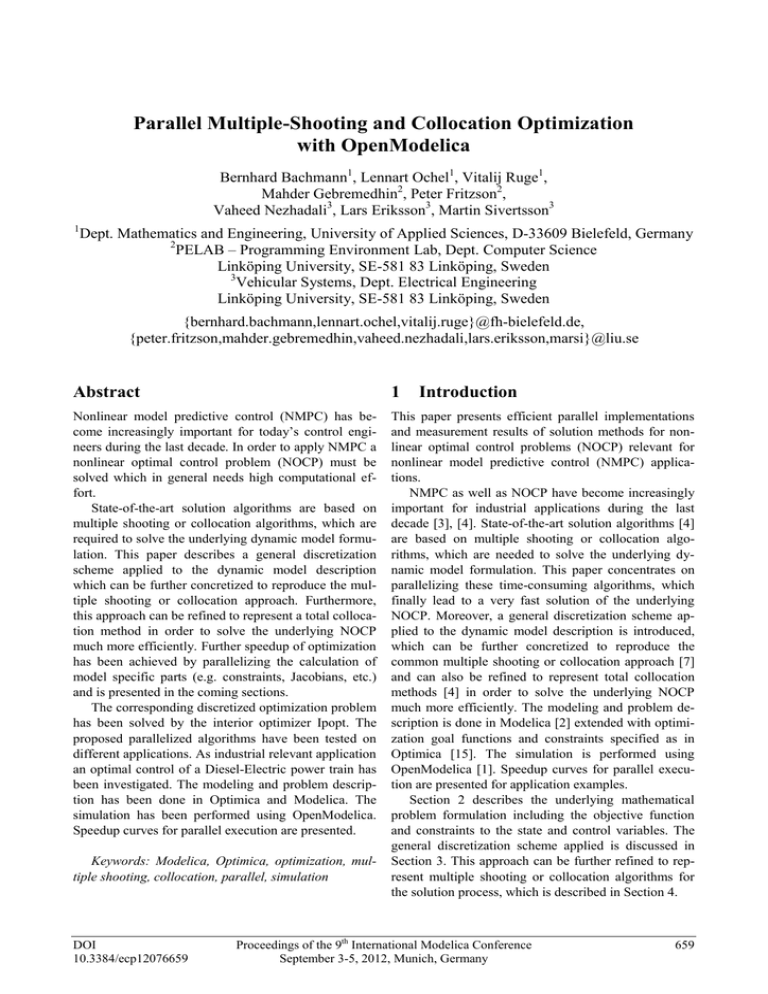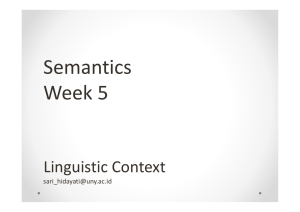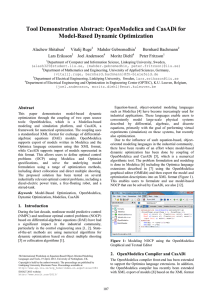Parallel Multiple-Shooting and Collocation Optimization with OpenModelica
advertisement

Parallel Multiple-Shooting and Collocation Optimization
with OpenModelica
Bernhard Bachmann1, Lennart Ochel1, Vitalij Ruge1,
Mahder Gebremedhin2, Peter Fritzson2,
Vaheed Nezhadali3, Lars Eriksson3, Martin Sivertsson3
1
Dept. Mathematics and Engineering, University of Applied Sciences, D-33609 Bielefeld, Germany
2
PELAB – Programming Environment Lab, Dept. Computer Science
Linköping University, SE-581 83 Linköping, Sweden
3
Vehicular Systems, Dept. Electrical Engineering
Linköping University, SE-581 83 Linköping, Sweden
{bernhard.bachmann,lennart.ochel,vitalij.ruge}@fh-bielefeld.de,
{peter.fritzson,mahder.gebremedhin,vaheed.nezhadali,lars.eriksson,marsi}@liu.se
Abstract
1
Nonlinear model predictive control (NMPC) has become increasingly important for today’s control engineers during the last decade. In order to apply NMPC a
nonlinear optimal control problem (NOCP) must be
solved which in general needs high computational effort.
State-of-the-art solution algorithms are based on
multiple shooting or collocation algorithms, which are
required to solve the underlying dynamic model formulation. This paper describes a general discretization
scheme applied to the dynamic model description
which can be further concretized to reproduce the multiple shooting or collocation approach. Furthermore,
this approach can be refined to represent a total collocation method in order to solve the underlying NOCP
much more efficiently. Further speedup of optimization
has been achieved by parallelizing the calculation of
model specific parts (e.g. constraints, Jacobians, etc.)
and is presented in the coming sections.
The corresponding discretized optimization problem
has been solved by the interior optimizer Ipopt. The
proposed parallelized algorithms have been tested on
different applications. As industrial relevant application
an optimal control of a Diesel-Electric power train has
been investigated. The modeling and problem description has been done in Optimica and Modelica. The
simulation has been performed using OpenModelica.
Speedup curves for parallel execution are presented.
This paper presents efficient parallel implementations
and measurement results of solution methods for nonlinear optimal control problems (NOCP) relevant for
nonlinear model predictive control (NMPC) applications.
NMPC as well as NOCP have become increasingly
important for industrial applications during the last
decade [3], [4]. State-of-the-art solution algorithms [4]
are based on multiple shooting or collocation algorithms, which are needed to solve the underlying dynamic model formulation. This paper concentrates on
parallelizing these time-consuming algorithms, which
finally lead to a very fast solution of the underlying
NOCP. Moreover, a general discretization scheme applied to the dynamic model description is introduced,
which can be further concretized to reproduce the
common multiple shooting or collocation approach [7]
and can also be refined to represent total collocation
methods [4] in order to solve the underlying NOCP
much more efficiently. The modeling and problem description is done in Modelica [2] extended with optimization goal functions and constraints specified as in
Optimica [15]. The simulation is performed using
OpenModelica [1]. Speedup curves for parallel execution are presented for application examples.
Section 2 describes the underlying mathematical
problem formulation including the objective function
and constraints to the state and control variables. The
general discretization scheme applied is discussed in
Section 3. This approach can be further refined to represent multiple shooting or collocation algorithms for
the solution process, which is described in Section 4.
Keywords: Modelica, Optimica, optimization, multiple shooting, collocation, parallel, simulation
DOI
10.3384/ecp12076659
Introduction
Proceedings of the 9th International Modelica Conference
September 3-5, 2012, Munich, Germany
659
Parallel Multiple-Shooting and Collocation Optimization with OpenModelica
In section 5 the general discretization scheme is further
methods.
developed towards total collocation
Industrial relevant Modelica applications are presented in Section 6. Parallel execution of the constraint
equations of the NOCP is performed in Section 7. The
results show reasonable speedups of the optimization
time when it comes to time consuming calculation of
the model equations. The necessary implementations
are partly realized in the OpenModelica Compiler,
which is described in Section 8. The paper concludes
with a summary of the achieved results.
2
The Nonlinear Optimal Control
Problem (NOCP)
The numerical solution of NOCP is performed by solving the following problem formulation [7][8]:
( )
( ( ) ( ) )
( ( ))
(2.1)
∫ ( ( ) ( ) )
subject to
( )
( ( ) ( ) )
̇( )
( ( ) ( ) )
( ( ))
(2.2)
(2.3)
(2.4)
(2.5)
Figure 1. Different trajectories achieved by varying control
variables. Only one trajectory fulfills the terminal constraint (red
dot).
The function
should be fulfilled at the final time point similar to the
terminal constraint (2.5). Since ( ( )) is part of the
objective function ( ( ) ( ) ) the applied optimization methods may not find a solution that fulfills the
corresponding terminal constraints, but should be very
close to it. The trajectories are influenced by changing
the control variables. Different trajectories using different control variables are visualized in Figure 1.
On the other hand, different trajectories could fulfill
the same terminal constraints. Taking into account the
whole time horizon by minimizing the second part
of the objective function will
∫ ( ( ) ( ) )
lead to the selection of the optimal trajectory. This behavior is visualized in Figure 2.
( )
where ( )
are the state and
control variables, respectively. The receding time horizon is given by the interval [
]. The constraints
(2.2), (2.3), (2.4) and (2.5) describe the initial conditions, the nonlinear dynamic model description based
on differential algebraic equations (DAEs, Modelica),
) and the
the path constraints ( ( ( ) ( ) )
terminal constraints.
Support for time-optimal control and corresponding
terminal constraints is work-in-progress and are not yet
provided by the current implementation.
2.1
Boundary Value Problems
The objective function (2.1), that needs to be minimized, includes conditions at the boundary time point
stated by the function ( ( )) as well as conditions taking into account the whole time horizon stated
by ∫ ( ( ) ( ) ) .
Figure 2. Different trajectories that fulfill the terminal constraint.
3
General Discretization Scheme
In order to apply a general discretization scheme the
NOCP formulation is rewritten to a general form which
later can be used to derive the different possible numerical algorithms e.g. multiple shooting, multiple or total
collocation algorithm, etc. [6]. Equations (2.2) and
(2.3) can be rewritten as follows:
( )
660
( ( )) describes conditions that
∫ ( ( ) ( ) )
Proceedings of the 9th International Modelica Conference
September 3-5, 2012, Munich Germany
(3.1)
DOI
10.3384/ecp12076659
Session 6A: Optimization
When discretizing the time horizon [
]
[
number of intervals [
tant
partitioning:
] into a finite
] (e.g. equidis-
) integral in (3.1) can be reformulated to
∫ ( ( ) ( ) )
(3.2)
∑∫
( ( ) ( ) )
Each integral
∫
( ( ) ( ) )
(3.3)
on a subinterval can now be treated independently, if
additional constraints are added to the NOCP formulation to force the calculation of an overall continuous
solution. Therefore, locally the problem reduces to a
boundary value problem [5] stated by
tailed descriptions of the multiple shooting algorithm
using local collocation can be found in [7]. The solution process for equation (3.4) in each subinterval can
be performed in parallel. The necessary calculation
time depends certainly on the chosen integration method. In case of an explicit integration algorithm, e.g.
Runge-Kutta based, more intermediate integration steps
might be necessary for certain accuracy than using an
implicit integration method, e.g. local collocation
methods. On the other hand, explicit integration methods just perform at each intermediate step an evaluation
of the model equations, whereas implicit methods in
general need to solve a system of non-linear equations,
which might also be time consuming. Nevertheless,
when the underlying system of ordinary differential
equations is stiff, implicit methods need to be applied.
NOCP
Discretizati
on Scheme
Multiple
shooting
(
)
∫
( ( ) ( ) )
(3.4)
[
],
( ) for
where ( )
.
It yields ( )
and continuity is forced by addi)
tional constraints (
added to the NOCP
formulation, which finally leads locally to a boundary
value problem. Each sub-problem (3.4) can be solved
independently and in parallel, if multiple shooting/collocation is applied. By varying the control variable ( ) in each sub-interval the solution of (3.4) can
be influenced in order to fulfill the overall continuity
constraints. In the current approach it is assumed that
]
( )
is constant for each subinterval [
4
Multiple Shooting or Collocation
Different numerical methods are available to solve
equation (3.4). The first approach presented within this
paper is the reformulation of (3.4) to an ordinary differential equation
( ( )
)
(4.1)
̇( )
with the initial condition ( )
.
In order to solve equation (4.1) an appropriate (e.g.
explicit/implicit) integration algorithm can be applied
that is already available in OpenModelica. A schematic
view of the algorithmic dependencies is presented in
Figure 3.
Alternatively, equation (3.4) or (4.1) can locally be
solved using collocation methods, which also can be
interpreted as numerical treatment of integration. De-
DOI
10.3384/ecp12076659
Numerical
Treatment
of
Integration
Figure 3. Schematic view of the algorithmic dependencies.
Although, equation (3.4) can be solved in parallel a lot
of time is used for finding exact solutions to a locally
defined problem, which might not be relevant for the
over-all problem stated by the (NOCP) formulation
(2.1)-(2.5). Therefore, the solution process for the
NOCP still needs a lot of computation time. The next
section describes methods to overcome this deficiency
by adding the locally derived residual equations (based
on locally applied collocation methods) to the over-all
NOCP formulation.
5
Total Collocation
Applying collocation methods for solving equation
(3.4) locally leads in general to a system of non-linear
equations for each sub-interval. The solution process of
these equations might be time consuming and with respect to the NOCP not efficient. If the corresponding
non-linear equations are added to the NOCP formulation and corresponding optimization algorithms have
access to the intermediate points used by the local collocation method a more efficient solution process can
be formulated [4]. This section presents two different
collocation methods.
Proceedings of the 9th International Modelica Conference
September 3-5, 2012, Munich, Germany
661
Parallel Multiple-Shooting and Collocation Optimization with OpenModelica
Based on the common Lagrangian polynomial
( ) for interpolation purposes, following abbreviations are introduced for
and
:
( )
The discretized NOCP using total collocation and
corresponding Gaussian quadrature formula for the
integral part of the goal function is finally described by:
( ( ) ( ) )
(
)
( )
∏
∑∑
( )
∑
∏
(
subject to
(
)
(
∫
∫
(5.3)
)
( )
)
(
(
where
are the supporting points within the
reference interval [ ]. Further abbreviations are defined by
( ),
and
(
).
NOCP
Discretization
Scheme
(5.4)
)
)
for
,
. For variant 1 the supporting points
, and weights
are given
based on Radau formulas.
(
)
are the additional residual equations from (5.1). For variant 1 the supporting
points
, and weights
are given
based on Lobatto formulas. (
)
are the additional residual equations from (5.2).
6
Modelica Applications
To investigate the performance of the proposed optimization algorithm, industrial relevant optimal control
problems are solved and corresponding results are presented in this section.
Total
Collocation
Figure 4. Schematic view of the algorithmic dependencies.
The first variant is dealing with the approximation of
the states which leads to the following formulas:
∑
(5.1)
6.1
Batch Reactor
We begin by considering a simple model from the
chemical reactor described in [7] to maximize the yield
of ( ) by manipulation the reaction temperature ( ),
with the following problem formulation:
∑
( )
In case of
this approach reduces to the implicit
Euler formula with approximation order 1.
The second variant is dealing with the approximation
of the derivatives of the states and leads to the formulas:
( ( ) ( ) )
subject to
̇ ( )
̇ ( )
( )
( ( )
( )
(5.2)
∑
(
662
( ( )
( )
)
(6.2)
( )
( )
( )
( )
( )
( ))
( )
where ( )
(6.1)
( )
∑∫
In case of
this approach reduces to an implicit
Runge-Kutta formula (trapezoidal rule) with approximation order 2.
( )
( )) and
Proceedings of the 9th International Modelica Conference
September 3-5, 2012, Munich Germany
(6.3)
( )
[
(6.4)
].
DOI
10.3384/ecp12076659
Session 6A: Optimization
and boundary conditions are:
at
̇
Figure 5. Trajectories of state and control variables
6.2
( )
Optimal control of Diesel-Electric powertrain
The Diesel-electric model based on [10] is presented in
Appendix A. This concept is modeled according to a
nonlinear mean value engine model (MVEM) containing four states and three control inputs while the generator model is simplified by considering constant efficiency and maximum power over the entire speed
range.
In a Diesel-electric powertrain the operating point
of the Diesel engine can be freely chosen which would
potentially decrease fuel consumption. Moreover, the
electric machine has better torque characteristics. These
are the main reasons making the Diesel-electric powertrain concept interesting for further studies.
To investigate the fuel optimal transients of the
powertrain from idling condition to a certain power
level while the accelerator pedal position is interpreted
as a power level request, the following optimal control
problem is solved:
at
and
̇
( )
̇
̇
,( )
.
The constraints are originated from components’ limitations and the functions are described in the appendix [10].
Figure 6. Trajectories of control variables
(
states
∫
subject to
(
̇
(
̇
(
̇
(
̇
(
(
(
) , controls
)
In this work, we try to find the fuel optimal control
and state trajectories in a certain time interval [
].
For simplicity, only diesel operating condition is assumed which means (
).
̇
)
)
)
)
)
( )
)
(
(
( )
( )
)
)
( )
(
)
( )
Figure 7. Trajectories of state variables
DOI
10.3384/ecp12076659
Proceedings of the 9th International Modelica Conference
September 3-5, 2012, Munich, Germany
663
Parallel Multiple-Shooting and Collocation Optimization with OpenModelica
The dynamic system is solved after it is discretized
into subintervals. Figure 6 and Figure 7 show the obtained control and state trajectories. As it is expected,
the fuel optimal results happen when engine is accelerated only near the end of the time interval (
)
to meet the end constraints while minimizing the fuel
consumption.
In section 7 it is shown how the parallel execution
increases the performance of the optimization process.
7
Parallel Execution and Performance Measurements
We have performed measurements for the different
algorithms (multiple shooting/collocation and total collocation with variant 1 and 2) applied to the above described applications. The C/C++ source code has been
compiled by gcc version 4.6.3 (GCC) with OpenMP
support. The measurements are done on an Intel Core
i7 CPU 870 with 8 cores @ 2.93 GH (4 real cores and 4
virtual cores).
The corresponding optimization problem is solved
by the interior point optimizer Ipopt [16]. Figure 8
shows the different functions and derivative information that need to be provided to Ipopt for the solution process. In the current implementation the Hessian
matrix of the corresponding Lagrangian formulation is
calculated numerically by Ipopt. The other information
(see Figure 8) is provided numerically by external routines. When calculating the Jacobian and Hessian matrices the treatment of the sparsity patterns, is important
for the performance of the multiple shooting and total
collocation methods [9]. This has been realized for the
Jacobian matrix calculation.
Ipopt
constraints
object
function
Jacobian
gradient
Hessian of the
Lagrangian
have been performed using 128 intervals when dealing
with sparse matrix representation. The user defined
functions (see blue boxes of Figure 8) have been parallelized.
7.1
Batch Reactor
The speedups obtained and the computation times for
the batch reactor are shown in Table 1 and Figure 9.
threads
1
2
4
8
multiple shooting
Ipopt
jac_g
1,5742s
1,0164s
0,6691s
0,6539s
28,93ms
16,77ms
9,37ms
8,52ms
multiple collocation
Ipopt
jac_g
18,47s
10,25s
5,825s
5,055s
343,3ms
188,3ms
104,7ms
89,57ms
Table 1. Computation times for the Jacobian of the constraints and
the over-all optimization using multiple shooting/collocation method
for the batch reactor
Figure 9. Speedups and computation times of the whole
optimization process
Table 1 shows that multiple collocation is much more
expensive than the multiple shooting. Reason for this is
the computational time needed to solve non-linear systems coming from the implicit discretization. Therefore, by parallelizing the user defined functions a better
speedup (Figure 9) for the whole optimization can be
performed for the multiple shooting method, whereas
the speedup for the user defined function (e.g. Figure
10) is comparable.
Figure 8. Schematic view of the required components of Ipopt
The multiple shooting algorithm uses an explicit
Runge-Kutta formula of order 3 as well as 3 steps within each interval. The multiple collocation method uses
3 intermediate interval points based on Radau formulas.
The total collocation uses variant dependent intermediate interval points as described in section 5. The tests
664
Figure 10. Speedups and computation times for the Jacobian of the
constraints
Proceedings of the 9th International Modelica Conference
September 3-5, 2012, Munich Germany
DOI
10.3384/ecp12076659
Session 6A: Optimization
7.2
Diesel Model
The solution process for the diesel model using multiple shooting and multiple collocation is quite time consuming (see Table 2 and Table 3). Especially, the multiple collocation algorithm was only performed with 32
intervals in order to reduce execution time to an acceptable level. Although, parallelization of the user
defined function leads to a great speed up, the overall
performance of the multiple shooting or collocation
method is still poor. The total collocation variants are
superior with respect to the over-all performance as can
be seen in Table 3.
threads
1
2
4
8
multiple shooting
Ipopt
jac_g
1518,4s
917,17s
608,29s
508,71s
1,8196s
0,9671s
0,5286s
0,3861s
multiple collocation
Ipopt
jac_g
368,07s
196,04s
108,33s
87,027s
2,6007s
1,3832s
0,7625s
0,6110s
Table 2. Computation times for the Jacobian of the constraints and
the over-all optimization using multiple shooting/collocation method
for the diesel model
threads
1
2
4
8
total collocation 1
Ipopt
jac_g
total collocation 2
Ipopt
jac_g
15,40s
11,49s
10,19s
9,452s
14,07s
10,10s
8,342s
7,897s
8,215ms
4,356ms
2,553ms
1,713ms
9,947ms
5,281ms
2,987ms
1,965ms
Table 3. Computation times for the Jacobian of the constraints and
the over-all optimization using total collocation method for the
diesel model
The speed-up regarding the user-defined function is
comparable to the multiple shooting or collocation
methods (see Figure 12). The speed-up of the whole
optimization process is not optimal due to the serial
computation and dense treatment of the Hessian matrix
calculated internally by Ipopt (see Figure 11).
Figure 11. Speedups and computation times of the whole
optimization process
DOI
10.3384/ecp12076659
Figure 12. Speedups and computation times for the Jacobian of the
constraints
8
Integration with OpenModelica
Support for specifying optimization goal functions and
constraints together with Modelica models has now
been implemented in OpenModelica. Such integrated
models can now be exported via XML to tools such as
CasADi [12] which can act as a frontend to ACADO
[13].
In the current OpenModelica prototype all aspects
of the tool chain are not yet completely implemented.
For example, we are currently using numerically derived Gradients, Jacobians and Hessians since the automatic differentiation machinery in OpenModelica has
not yet been extended to operate on the optimization
problem goal function.
However, the prototype is complete enough to do
the measurements of the included model applications
on a parallel platform to obtain the speedup curves for
parallel execution on 1-8 cores.
The OpenModelica compiler has been extended to
export Modelica Models to XML based on an extended
version of the FMI XML schema from [14]. The XML
export, in addition to the standard Modelica syntax,
supports the Optimica extensions from Jmodelica [15].
Theses extensions allow users to formulate dynamic
optimization problems to be solved by a numerical algorithm. The extensions include several constructs including a new specialized class optimization, a constraint section, etc. See the batch reactor example below as well as the Optimica manual for complete information.
optimization BatchReactor
(objective = -x2(finalTime),
startTime = 0, finalTime =1)
Real x1(start=1,fixed=true,min=0,max=1);
Real x2(start=0,fixed=true,min=0,max=1);
input Real u(free=true, min=0, max=5);
equation
der(x1) = -(u+u^2/2)*x1;
der(x2) = u*x1;
end BatchReactor;
Proceedings of the 9th International Modelica Conference
September 3-5, 2012, Munich, Germany
665
Parallel Multiple-Shooting and Collocation Optimization with OpenModelica
The XML generated for flattened Optimica Models can
be imported into other non-Modelica Optimization
tools like ACADO.
Currently the OpenModelica compiler does not yet
use the optimization problem formulation internally as
input to automatic differentiation. The Modelica plus
Optimica model description is flattened, some common
compilation phases are applied e.g. syntax, semantics
and type checking, simplification, constant evaluation
etc. and then the complete flat model is exported to
XML.
9
Conclusions
In this paper parallelized implementations of several
different algorithms for solving NOCP have been presented. The well-known multiple shooting or collocation as well as total collocation methods are derived
using a general discretization scheme. Total collocation
methods have proofed at least in the current implementation and for the tested applications to be superior to
the other algorithms.
The corresponding discretized optimization problem
has been solved by the interior optimizer Ipopt. Further
speedup of the optimization process for all described
algorithms have been achieved by parallelizing the calculation of model specific parts (e.g. constraints, Jacobians, etc.). So far the evaluation of derivatives have
been done numerically. This will be further improved
using the already available symbolic differentiation
capabilities of OpenModelica [11]. Finally, this work
will be continued by applying the proposed algorithms
on more industrial relevant applications together with a
thorough testing on advanced parallel hardware architectures.
10 Acknowledgements
This work has been partially supported by Serc, by SSF
in the EDOp project and by Vinnova as well as the
German Ministry BMBF (BMBF Förderkennzeichen:
01IS09029C) in the ITEA2 OPENPROD project. The
Open Source Modelica Consortium supports the
OpenModelica work.
References
Modelica Standard Library 3.1. Aug. 2009.
http://www.modelica.org.
[3] Jasem Tamimi, Pu Li. A combined approach to
nonlinear model predictive control of fast systems. Journal of Process Control, 20, pp 1092–
1102, 2010.
[4] Biegler, Lorenz T. 2010. Nonlinear Programming: Concepts, Algorithms, and Applications to
Chemical Processes. s.l. : Society for Industrial
Mathematics, 2010.
[5] Munz, Claus-Dieter and Westermann, Thomas.
2009. Numerische Behandlung gewöhlicher und
partieller Differenzialgleichungen. Berlin Heideberg : Springer Verlag, 2009
[6] Heuser, Harro. 2006. Gewöhnliche Differentialgleichungen. Wiesbaden : Teubner Verlag, 2006.
[7] Tamimi, Jasem. 2011. Development of Efficient
Algorithms for Model Predictive Control of Fast
Systems. Düsseldorf: VDI Verlag, 2011.
[8] Friesz, Terry L. 2007. Dynamic Optimization and
Differential Games. US: Springer US, 2007.
[9] Folkmar, Bornemann und Deuflhard, Peter. 2008.
Numerische Mathematik: Numerische Mathematik 2: Gewöhnliche Differentialgleichungen: Bd
II: [Band] 2. s.l. : Gruyter, 2008.
[10] Martin Sivertsson and Lars Eriksson Optimal
power response of a diesel-electric powertrain.
Submitted to ECOSM’12, Paris, France, 2012.
[11] Braun, Willi, Ochel Lennart and Bachmann
Bernhard. Symbolically Derived Jacobians Using
Automatic Differentiation - Enhancement of the
OpenModelica Compiler, Modelica Conference
2011
[12] Joel Andersson; Johan Åkesson; Moritz Diehl,
CasADi - A symbolic package for automatic differentiation and optimal control, Proc. 6th International Conference on Automatic Differentiation, 2012.
[13] Houska, B., Ferreau, H.J., and Diehl, M. (2011).
ACADO toolkit - an open source framework for
automatic control and dynamic optimization. Optimal Control Applications & Methods, 32(3),
298-312.
[14] Functional Mock-up Interface:
http://www.functional-mockupinterface.org/index.html
[1] Open Source Modelica Consortium. OpenModelica System Documentation Version 1.8.1, April
2012. http://www.openmodelica.org
[15] Johan Åkesson. Optimica—An Extension of
Modelica Supporting Dynamic Optimization. In
6th International Modelica Conference 2008.
Modelica. Association, March 2008
[2] Modelica Association. The Modelica Language
Specification Version 3.2, March 24th 2010.
http://www.modelica.org. Modelica Association.
[16] Interior Point OPTimizer (Ipopt)
https://projects.coin-or.org/Ipopt
666
Proceedings of the 9th International Modelica Conference
September 3-5, 2012, Munich Germany
DOI
10.3384/ecp12076659
Session 6A: Optimization
11
Appendix A
Figure 13. Diesel Engine Model
Powertrain model
̇
Intake System
Compressor
(
̇
̇
̇
,
√
,
)
(
̇
̇
) ,
(
√
)
Intake manifold
( ̇
̇
̇ ),
Cylinder
Gas Flow
̇
,
̇
,
̇
(
)
Torque
(
,
(
(
̇
,
)
),
(
)
(
,
)
)
Temperature
̇
,
̇
(
)
̇
(
,
(
)
)
(
(
(
)
)
)
Exhaust System
Exhaust Manifold:
̇
( ̇
̇
̇
),
Turbine
(√
,
̇
̇
)
(
),
̇
,
√
(
(
)
√
)
((
),
(
)
),
̇
,
Wastegate
,
DOI
10.3384/ecp12076659
(
(
)
),
√
((
)
(
)
),
̇
√
Proceedings of the 9th International Modelica Conference
September 3-5, 2012, Munich, Germany
667
Parallel Multiple-Shooting and Collocation Optimization with OpenModelica
Model Constants
Symbol
(
Description
Value
Unit
Ambient pressure
1.011e5
Pa
Ambient temperature
298.46
K
Specific heat capacity of air, constant pressure
1011
J/(kg.K)
Specific heat capacity of air, constant volume
724
J/(kg.K)
Specific heat capacity ratio of air
1.3964
-
Gas constant, air
287
J/(kg.K)
Specific heat capacity of exhaust gas, constant pressure
1332
J/(kg.K)
Specific heat capacity ratio of exhaust gas
1.2734
-
Gas constant, exhaust gas
286
J/(kg.K)
Specific heat capacity ratio of cylinder gas
1.35004
-
Intake manifold temperature
300,6186
K
Pressure in exhaust system
1.011e5
Pa
Stoichiometric oxygen-fuel ratio
14.54
-
Diesel heating value
42.9e6
J/kg
Description
Value
Unit
Number of cylinders
6
-
Engine displacement
0.0127
Compression ratio
17.3
Inertia of the engine-generator
3.5
Volume of intake system
0.0218
Compressor radius
0.04
M
Max. compressor head parameter
1.5927
-
Max. corrected compressor mass flow
1.2734
-
Compressor efficiency
286
J/(kg.K)
Volumetric efficiency
1.35004
-
Combustion chamber efficiency
0.6774
-
Friction efficiency
1.011e5
Pa
Friction efficiency
14.54
-
Friction efficiency
42.9e6
J/kg
Non-ideal Seliger cycle compensation
1.054
-
Ratio of fuel burnt during constant volume
0.4046
-
Volume of exhaust manifold
0.0199
Turbocharger inertia
1.9662 e-4
Turbocharger friction
2.4358 e-5
Effective turbine area
9.8938 e-4
Turbine efficiency
0.7278
-
Wastegate parameter
0.6679
-
Wastegate parameter
5.3039
-
Effective wastegate area
8.8357 e-4
)
Model Parameters
Symbol
̇
668
Proceedings of the 9th International Modelica Conference
September 3-5, 2012, Munich Germany
-
DOI
10.3384/ecp12076659






